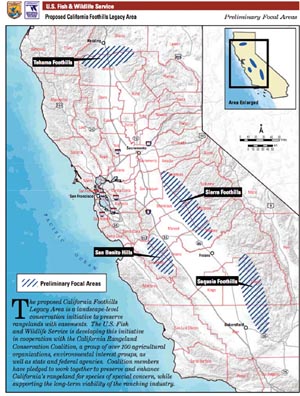
San Benito County supervisors had their first face-to-face
discussion with a U.S. Fish and Wildlife Service official over the
federal government’s proposal to sell easements to rangeland
property owners throughout the Central Valley and San Benito County
in an effort to conserve wildlife habitat.
San Benito County supervisors had their first face-to-face discussion with a U.S. Fish and Wildlife Service official over the federal government’s proposal to sell easements to rangeland property owners throughout the Central Valley and San Benito County in an effort to conserve wildlife habitat.
Supervisors heard the presentation from fish and wildlife chief of refuge planning, Mark Pelz, about six weeks after the agency held a public forum with residents at the packed Veterans Memorial Building in Hollister – where a majority of speakers were opposed to the idea.
At Tuesday’s meeting, a smaller group of six local citizens also shared their opinions with the board about the proposed California Foothills Legacy Area. All but one of those speakers were supportive of the proposal.
Supervisors appeared less certain about taking their own stances during the hour-long discussion, but some of them were more willing to express disappointment about the planning process and that county leaders weren’t informed about the proposal until shortly before the June public hearing. Board members also showed concern with some unanswered questions, such as the possible impact on property values and potential decreases to county revenue.
“I think we feel this has potential of affecting a lot of our land and we were not included in the planning process,” said District 4 Supervisor Jerry Muenzer, who represents a largely rural area, mostly in southern San Benito County. “That’s one of the reasons we felt this was off to a bad start.”
The U.S. Fish & Wildlife Service in May released its proposal to buy the conservation easements while stating intentions to protect endangered and threatened species – nearly 200 were identified – and prevent over-development. It outlines an 18 million-acre study area affecting 26 counties. Within that study area, the federal agency breaks down the proposal into four “focal areas” making up 3.4 million acres – one of which is the “San Benito Hills” that includes nearly 500,000 acres in the county.
Fish and wildlife has reported that it initially wants to buy easements on 900,000 acres in total. With an estimated cost of $1,000 per acre, the federal government would pay about $900 million to purchase the easements.
Those easements would carry restrictions on landowners. County and state cattlemen have opposed the idea, citing regulations placed on them once the federal government has legal means of access to properties.
Although he was in the minority Tuesday, landowner Roger Miller recalled his own experience that fits in line with the concerns from those cattlemen associations.
He is a part-owner of a 1,000-acre duck club in Los Banos. He said that in 1985, fish and wildlife approached the waterfowl habitat owners about selling them easements on the land. Miller claimed he was told to “keep doing what you’re doing and everything will be fine.”
It went fine for a while, but “then things changed,” he said. Miller said the owners and federal government had differing interpretations about the legal phrase “natural character of the land.” He contended that in one instance a fish and wildlife worker forced someone off a tractor on the property, threatening they would be sued.
“They were intimidating us,” he said. “They were harassing us.”
Miller noted that Supervisor Anthony Botelho “shares” the duck club with the other owners.
“As a landowner, you no longer can run your property as you see fit because of the Endangered Species Act,” Miller said.
Other public speakers – some own land that could be affected by the proposal – disagreed with Miller’s argument and asserted more confidence in the federal government’s ability to achieve the goal of conserving wildlife.
County landowner Kate Woods, whose family owns 261 acres near New Idria, said they “fully” support the easement plan. She called the opposition’s take “odd” because the program is voluntary and said some detractors already receive subsidies “for essentially not growing certain crops.”
“Why would they want to prevent other county residents from getting back a little bit of what we’ve been forced to give the federal government in taxes over the course of our working lives?” Woods said. She believes properties neighboring those accepting easements could gain from increased property values. She went on to explain that her family lives on “very steep, hilly land” in a boxed canyon.
“There’s not much we can do with it agriculturally,” she said. “We can’t grow crops. We can’t have cattle. So if the feds want to pay us for essentially doing nothing, I welcome it.”
Another Panoche Valley speaker, Kevin Davis, pointed out that Santa Clara County developers have to pay $16,000 to $24,000 an acre into a fund for nature conservation, that there is scarce open space remaining there.
“Nature and open land is worth a lot to them,” he said. As for San Benito County, he said, “I’m up to my knees in nature – it’s everywhere.”
Once the public spoke, supervisors made it clear that they weren’t ready to support or oppose the proposal.
Muenzer, Botelho and Supervisor Robert Rivas all said they were concerned about a prospective hit to property values – and revenue for the financially struggling county.
Rivas pointed out that the county just finished a grueling budget process.
“I don’t think we could stand to lose very much more (revenue),” he said.
Rivas, however, also said a program that “seeks to protect and conserve our local heritage, which is agriculture and open space, is a good thing.”
Supervisor Margie Barrios said she appreciated hearing the pros and cons of the proposal. She noted that the county sent a letter with eight questions to fish and wildlife and received a response, but that those uncertainties remain unanswered. She asked about the perpetuity requirement in the easements, meaning the agreements would last forever, and whether there is any possibility for a clause to allow buyers to reverse their decisions.
Pelz’s response was simply, “They are permanent.”
Supervisor Jaime De La Cruz kept his comments brief.
“I want to thank the public for your good comments,” De La Cruz said. “I do appreciate these comments. I will take these new comments, very valuable comments, into consideration.”
As Muenzer acknowledged, though, supervisors won’t have any votes in the final decision.
“What we’re looking for is answers to see if we can support it or not,” Muenzer said.
When Botelho had his chance to speak, he reiterated Miller’s concern about the duck club property.
“That’s concerning to the fact that, it had to disturb you hearing that,” Botelho told Pelz. “Do you have any comments to answer to some of those concerns?”
Pelz said he was unaware of the specific case involving the duck club, but conjectured that in some cases the “language of the easement is not clear enough.”
“I’d like to get to the bottom of it,” Pelz said of Miller’s experience, “because I don’t think it’s reflective of our larger program.”
As for the related timelines, Pelz said the federal agency hopes to have a draft plan available in early 2012 and a final decision by next summer.








